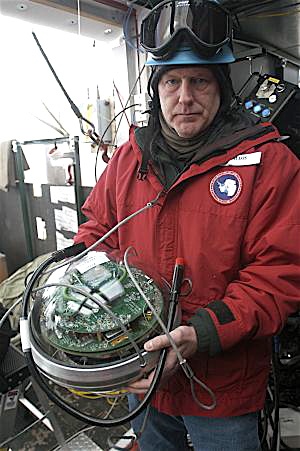World's largest scientific instrument nearing completion -- encompasses one cubic kilometer of ice!
Down at the South Pole, the world's largest
scientific instrument is almost ready to start detecting cosmic neutrinos. It's
so big and so sensitive, it will use the Earth as a filter.

When complete, 4,200 of these digital optical sensors will be in place.
An international team of scientists and engineers has taken a major step toward completion of what will be the world’s preeminent cosmic neutrino observatory, harnessing a sophisticated hot-water drill to build an observatory under the South Pole that eventually will encompass a cubic kilometer of ice.
Scientists leading a consortium building the massive neutrino telescope known as IceCube say that this year they have nearly doubled the size of the detector now under construction at the National Science Foundation’s Amundsen-Scott South Pole Station.
Although work can only take place from October through February-the fleeting and still frigid summer season at the Pole-the extent and pace of construction this year means that the observatory may soon begin scientific operations. IceCube is scheduled for completion in 2011.
When IceCube is completed, a cubic kilometer of the ice beneath the Pole will have been seeded with more than 4,200 optical sensors to capture telltale traces of the neutrinos and follow their tracks back to their distant points of origin. In addition, another 300 or so sensors will be deployed in tanks on the surface of the polar ice.
When fully operational, IceCube will sample neutrinos from the sky in the Northern Hemisphere. The detector will use the Earth as a filter to exclude other types of neutrinos, such as those from the sun, which could confuse the detector. Its primary scientific mission will be to identify the sources and distribution of the highest energy neutrinos created by violent cosmic events.
Rock on!
Posted: Fri - March 31, 2006 at 06:26 AM